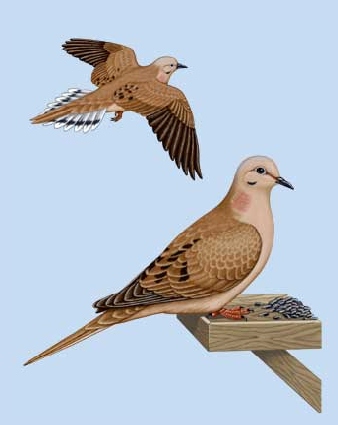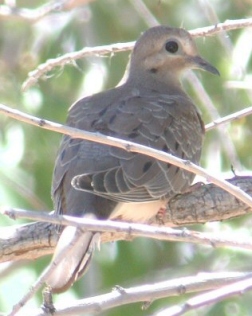|

Medium-sized dove
with gray-brown upperparts and pink-brown underparts. Eyes are dark
with a small, black spot beneath. Bill is dark. Wings are gray-brown
with black spots and dark primaries. Tail is long and pointed with
black-edged white tips on outer feathers. Swift direct flight.

|
MOURNING
DOVE
Zenaida macroura
COLUMBIFORMES
Pigeons and Doves (Columbidae)
Range and Habitat
Breeds from southeastern Alaska, Saskatchewan, Ontario, Quebec, and
New Brunswick southward to Mexico and Panama. Spends winters north to
the northern U.S.
Favorite habitats include open fields, parks, and lawns with many trees
and shrubs.
SOUNDS: "coo-ah, coo-coo-coo"
The oldest documented wild Mourning Dove was 19.3 years old. The average
lifespan of wild birds is 1.5 years.
It is a game bird; and in many states, habitat is created with the specific
purpose to hunt birds. Both males and females secrete a substance from
their crop that is high in protein and fat. Called crop milk or pigeon
milk, it resembles and smells like cottage cheese and is fed to young
birds.
A group of doves has many collective nouns, including a "bevy",
"cote", "dole", "dule", and "flight"
of doves.
The Mourning Dove has a large range, estimated globally at 11,000,000
kilometers. Native to the Americas and nearby island nations, this bird
prefers wetland, forest, and shrubland ecosystems though it can reside
on arable land or in rural
and urban areas.

|